
Credit: College of ACES, University of Illinois.
URBANA, Ill. – Food insecurity is a major problem in the U.S., and it worsened during the COVID-19 pandemic. The Supplemental Nutrition Assistance Program (SNAP) provides some relief, but millions of Americans still lack adequate access to healthy food. A new study from the University of Illinois proposes a potential solution.
“Restructuring SNAP as a Universal Basic Income (UBI) program or modified UBI is a straightforward way to eliminate food insecurity in United States. It’s expensive but it is not difficult,” says Craig Gundersen, distinguished professor in the Department of Agricultural and Consumer Economics at U of I. Gundersen authored the study, published in Food Policy.
While the existing SNAP program effectively reduces food insecurity, it has some limitations. For some SNAP recipients, the amount of aid they receive is insufficient. Some people who are food insecure and eligible for SNAP do not participate. And finally, more than half of those who are food insecure are not eligible for SNAP, Gundersen explains.
Using data from the 2019 Current Population Survey, Gundersen estimates the effects of expanding SNAP to become a UBI program under three different scenarios.
“The first scenario is a standard UBI program, where everybody in the United States gets SNAP at the maximum level,” Gundersen explains. “Under the current program, your SNAP benefits go down if your income increases. Under this proposal, the amount would remain the same. If people wanted to work more and earn more money, they wouldn’t lose their SNAP benefits.”
Under this scenario, food insecurity could decline by 88.8 %, assuming the $730 billion cost would be funded through higher taxes for top-earning households.
“With the current distribution of taxes in the United States, the top 10% of incomes pay 70% of the taxes, and the top 50% pay 97%. Even if you were to raise taxes on the higher-income brackets to implement this program, it is unlikely to influence the probability of these households becoming food insecure,” he states.
The second scenario in Gundersen’s study would be a modified UBI program where households with incomes up to four times the poverty line; that is, approximately $100,000 for a family of four, would receive SNAP benefits.
Compared to the first scenario, the decline in food insecurity would be almost the same – 88.5% ¬ – but at a much lower cost of $408.5 billion.
Gundersen’s third scenario addresses the issue that current SNAP benefits are not enough for some recipients to become food secure.
“Under this scenario, I consider what would happen if we increase the maximum SNAP benefit by 25% and give it to all households with incomes up to about $100,000 a year. In that case, there would be a 98.2% decline in food insecurity, and the cost would be $564.5 billion,” he notes.
“I believe the third scenario is the best one,” Gundersen says. “While the second one is also good, it would not be adequate for some of the most vulnerable groups; that is, SNAP recipients who need more assistance than they currently receive. The third scenario would ensure that they get what they need to become food secure.”
Gundersen acknowledges that his proposals are costly, but so are other government programs.
“Essentially, I propose a way of eliminating food insecurity in United States, and the cost of this would be about a half trillion dollars per year. That seems like a lot, but to put it in context, the cost of the COVID-19 pandemic stimulus packages from the Trump administration and the Biden administration were roughly $6 trillion. It’s a lot of money. But if we want to be serious about alleviating food insecurity, this is a simple, straightforward way to do it,” he concludes.
###
The Department of Agricultural and Consumer Economics is in the College of Agricultural, Consumer and Environmental Sciences, University of Illinois.
Gundersen’s paper, “Viewpoint: A proposal to reconstruct the Supplemental Nutrition Assistance Program (SNAP) into a universal basic income program for food,” is published in Food Policy. [https:/
Media Contact
Marianne Stein
[email protected]
Original Source
https:/
Related Journal Article
http://dx.





